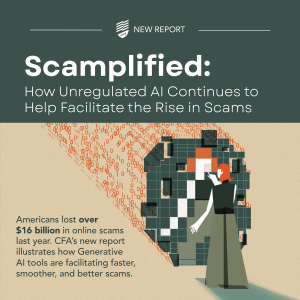Americans lost over $16 billion dollars in scams and fraud perpetrated online last year, according to the latest FBI statistics. Nearly $5 billion dollars was lost by seniors alone – and due to systemic underreporting issues, that number is certainly higher.
The amount lost rose 33% from 2023, with massive increases in tech support scams (58% increase), extortion scams (91% increase), phishing attempts (273% increase), and identity theft (38% increase).
CFA’s new report illustrates how a whole host of generative AI tools on the market are facilitating faster, smoother, and more convincing scams:
- Text-based tools, including chatbots, allow for rapid content creation without obvious spelling or grammar errors, consistent and personalized messaging, and scripts for robocalls and emails.
- Image-generation tools are being used for impersonation, extortion, false advertising, engagement-bait, and low-quality AI-generated content across social media feeds.
- Voice-generation tools allow scammers to impersonate loved ones or government authorities, bypass voice verification, and escalate romance scams.
- Video-generation tools, like deepfakes, are now used in celebrity or government impersonation, extortion schemes, and tech-support fraud.
While scams have existed forever, a whole host of new technologies are making them easier to execute. Beyond AI, there is underregulated tech across the entire “anatomy of a scam”:
- Data brokers sell detailed personal data, enabling hyper-targeted scams based on demographics, behavior, location, and relationships.
- Robotexters, caller-ID spoofers, and unregulated ad platforms push scam content, aided by under moderated social media feeds, weak spam filters, insecure videoconferencing tools, and mass email services.
- Payment platforms, banks, and crypto wallet providers often unwittingly facilitate fund transfers.
- Reporting mechanisms, typically controlled by phone, email, and social media providers, are often slow or ineffective in helping consumers respond to these scams.


